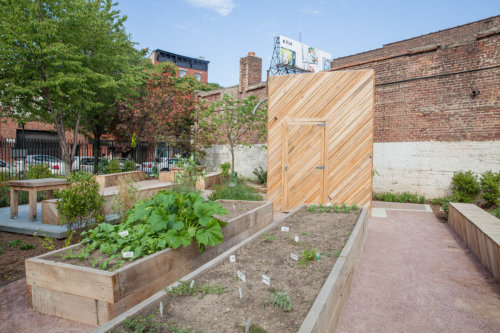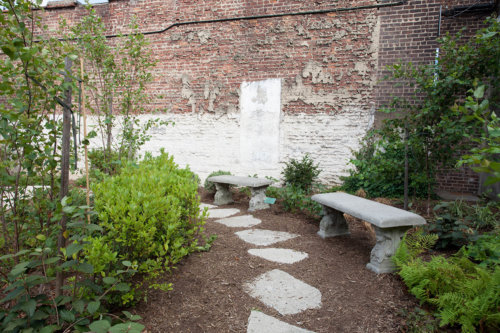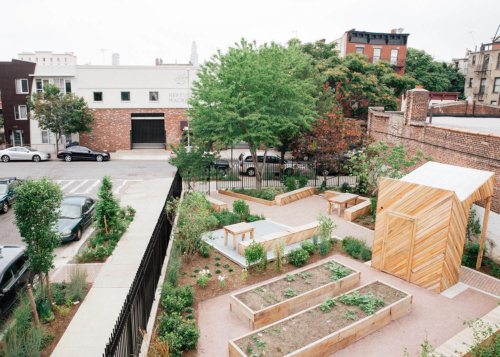The Story Behind New York City’s First Stormwater Management Park
From the outside, Gil Hodges Carroll Street Community Garden in Gowanus, Brooklyn looks like an ordinary public garden. It’s a large space with room to picnic, two large gardening beds, and even a fragrance walk. Yet, in 2013, the garden, named after the Brooklyn Dodgers baseball player, underwent a massive renovation making it the largest and most sophisticated stormwater management system within New York City’s public gardens. This was not a simple task, and took multiple partnerships. The renovation was sponsored by Jo Malone London and the New York Department of Education and the Department of Environmental Protection, and according to initial reports, the renovation cost upwards of $245,000 dollars.
Form follows function in multiple ways throughout this garden, as the renovation brought not just a new look, but a reading area and fragrance walk which was inspired by the perfumes of Jo Malone London– intended both as inspiration and to attract wildlife and encourage pollination through scent. (The plants include sweetbay magnolia, ruby spice summersweet, orange azalea and mountainmint.)
Gil Hodges is one of New York Restoration Project’s 52 community gardens in the 5 boroughs, which are dedicated to transforming open city spaces into greener and more sustainable city. The NYRP was founded in 1995 by Bette Midler, the award-winning singer and actress, who bought many of the city’s lots that were in danger of being sold to developers. To date, these spaces function as independent, community-run gardens, where volunteers from the community maintain and keep the space open, coordinating with one another.
The stormwater management system at Gil Hodges Carroll Street Community Garden was designed by engineers with the help of CUNY’s “Sustainability In The Urban Environment” program and their data analytics, who also keep track of the water management system underground and the amount of water collected. It includes “bioswales”, which are planted areas along the sidewalk that collect stormwater when it rains, and rain gardens, which improve local water quality by capturing storm water runoff and preventing the sewer from overloading with polluted water and draining into the nearby Gowanus Canal.
The canal was a huge factor that pushed the renovation forward. The Gowanus canal is one of the most polluted waterways in America, and the renovation is a way to mitigate its toxicity, with the intention that it will one day be possible to canoe there recreationally. “The history of flooding in Gowanus is pretty massive because of the canal,” Amanda Brown, Director of Community Engagement at NYPR, told Garden Collage. “The water would come up to people’s car tires.” The first year of the installation aimed to absorb 150,000 gallons of water annually– a goal that the project has since accomplished.
The process of coming up with this renovation involved speaking with community members and those utilizing the space, while also taking into account the future of the park and its potential for use. It’s a balance between the present day and the future. “Every renovation is different because it’s based on community input and current and anticipated use.” The capital team is responsible for combining these needs into one useful design, which integrates considerations like shade and canopy coverage, how many trees will get to stay, old trees that will need to go out, and the structure of the garden (as well as solar plants and composting toilets). With regards to future renovations, Brown says: “Solar is definitely the next wave that our team is interested in.” And they’re constantly looking at new ways to implement this and other new opportunities for partnership.
When it comes to renovation, NYRP is concerned with optimizing flood-control spaces for communal use. Currently, Paradise Garden in the Bronx is working on how to find a way to install more solar panels and solar-powered electricity.
But as with most community-improvement endeavors, maintaining the garden takes a team. There are multiple program partners that assist with keeping the garden open and running, and it’s usually open throughout the mornings and afternoon until the late fall or early winter. The church across the street and some of the local residents work on the composting committee, and local community members make sure the doors are open on a daily basis.
Apart from the daily maintenance, the space is home to exciting performances and community workshops. Previously, the NYRP has collaborated with BAM (the Brooklyn Academy of Music) to host an interactive dance performance as part of the organization’s “Arts in the Gardens” initiative. They’ve also collaborated with the Textile Arts Center, NYRP Education, and NYC Compost Project to host community workshops. In a city where it can be hard to find an empty seat, the garden is open to stop by for a picnic, facilitate a workshop, or even host a full-on party. The benefits to storm water management, it appears, are just a bonus.





































